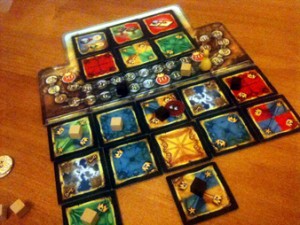Review: Basilica
Posted by James (admin) on November 7th, 2010
 Basilica is a fast, relatively simple and tight 2-player only game where players are building a cathedral and trying to score the most points. It may start out as a nice amiable building game but, don’t be deceived, soon you’ll be obstructing your opponent as much as assisting your own building.
Basilica is a fast, relatively simple and tight 2-player only game where players are building a cathedral and trying to score the most points. It may start out as a nice amiable building game but, don’t be deceived, soon you’ll be obstructing your opponent as much as assisting your own building.
THE GAME
The main game components are the double-sided game tiles – coloured vault floor on one side and an order (special action) on the other. Each player has 5 builders (cubes) as well as one coin. On the game board are 2 rows of 3 tiles – the bottom row are vault side up and the top row are order side up. The game board also shows the current scores and the king’s progress.
On their turn, a player performs 3 actions in any mixture. The actions are:
Place a vault tile: The player places one of the 3 available vault side up tiles orthogonally next to an already placed vault tile or one of the game board’s 5 starting spaces. Vault tiles shows either one or two colours – red, yellow, blue, green. The order tile in the row above is flipped over to the bottom row to become the replacement vault tile (and a tile from the draw stack fills-in the top row order side up).
Place a builder: If a player just placed a vault tile, they can place a builder (cube) on that tile.
Execute an order: The player executes one of the 3 orders shown on the tiles in the top row. These add/move/upgrade builders, remove empty tiles, add scaffolding tiles (non-scoring blockers) and add stained glass windows (bonus points). Some orders allow the opponent to execute part of the order too if they give a coin to the player executing the order. The order tile is removed and a new one from the draw stack replaces it.
Placing some vault tiles moves the king one space along the score track, and scoring occurs when the king reaches the 10th, 20th and 30th spaces. When scoring, each group of neighbouring tiles that are the same colour is assessed (tiles with 2 colours count as both colours). The player with the majority of builders on a group of tiles scores 1 point for each tile in the group, and the opponent scores 1 point for each builder they have on that group.
After scoring, all the builders are removed as are scaffold tiles and the first to rows of cathedral tiles too. The game ends after the 3rd scoring, or if the tile draw stack runs out for the 2nd time (when there is one final scoring).
 THOUGHTS
THOUGHTS
Overall, Basilica is a game with relatively few options but lots of ways to combine them so there’s lots of tactical potential. The background of the order side of the tiles shows what colour(s) it will be if flipped over to become a vault tile; plus, you can see the next order that will enter play because it is the top of the draw stack. This information helps you plan your actions to combine well. The orders that promote builders can make them worth 2 builders or win ties, which can really swing a majority battle. In future games, we will both use these even more.
As the king’s movement along the score track is determined by the player’s actions, players can affect when scoring occurs. Also, it’s a way to affect the game duration. This adds an extra element to watch out for.
Up to our first scoring round, play was very polite and we built good scoring areas without much interference in each other’s work. However, then we started to compete over areas a lot more, and ended in all out warfare with as much destruction/interference as there was construction. This interaction really adds to the game and you start to combine actions together for maximum effect. Removing an empty tile to cut a chunk off of an opponent’s high scoring area is great; however, filling the newly created gap with a scaffold tile straight after to stop them re-connecting the area is even sweeter.
So, what are the downsides? I didn’t feel there were any obvious flaws. Flipping and placing new tiles was little fiddly but nothing major. I wonder if it may be hard to catch up if you fall too far behind; however, my opponent made up a lot of ground in the last round with a well-timed and well-placed x2 upgrade which doubled his big area’s score. So, I’m not convinced ‘catch-up’ will be an issue. As the available tiles are random, you can find yourself without the options you want to secure/attack a specific area, but I don’t see this as a major issue either as both players are likely to be affected equally and you can always do something else instead.
I pre-ordered Basilica before Essen based on reading the rules. I’m very pleased that the game did not disappoint and plays very nicely. What I like is how the small amount of options available each turn can be combined in lots of ways for different effects. You need to work out how to accomplish good actions for yourself whilst removing specific tiles from those available so the other player can’t use them on their next turn and this makes it an exciting game.
James.
[Played with 2 players]

